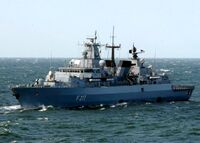Brandenburg-class Frigate
The F123 Brandenburg-class is a class of German frigate. They were ordered by the Federal Navy in June 1989, and then completed and commissioned between 1994 and 1996 to replace the Hamburg-class destroyers. These frigates primarily carry out antisubmarine warfare, but they also contribute to antiaircraft warfare defenses, the tactical command of squadrons, and surface-to-surface warfare operations. Their design includes some stealth features.
Currently the F123 class is being upgraded under the auspices of the Fähigkeitsanpassung FüWES (FAF) project. The primary component being upgraded under this program is the Combat Management System, for which a version of the Thales Nederland TACTICOS system will be used. The ships will also receive an IFF upgrade, to the EADS MSSR 2000 I secondary radar system. However, its primary radars, specifically its long-range 2D search radar, the Thales Nederland LW08, and its medium-range 3D surveillance radar, the Thales Nederland SMART-S, are to remain. The ships were to receive low-frequency active sonars under the Franco-German LFTASS programme but the French withdrew in 2000 and are now using a derivative of the British Sonar 2087; Bayern received the prototype TASS 6-3 sonar, though eventually all German warships were equipped with it with an improved version being developed.
Specifications[edit | edit source]
- Type: Frigate
- Service Period: 1994-Present
- Characteristics
- Length: 455.5 feet (138.84 meters)
- Beam: 55 feet (16.77 meters)
- Draught: 17.65 feet (5.38 meters)
- Displacement: 3,600 tons (Full Load)
- Crew: 219 (26 officers and 193 enlisted)
- Propulsion: CODOG (combined diesel or gas), two propeller shafts, controllable pitch propellers, two MTU 20V 956 TB92 diesel-engines, 8.14 MW each, two General Electric LM2500 gas turbines, 38 MW each, two Renk BGS 178 Lo gearboxes
- Range: 4,000 nautical miles (7,408 kilometers) at 18 knots (33.34 km/hr)
- Speed: 32.5 knots (60.19 km/h)
- Sensors and Processing Systems
- Thales LW08 air search D band radar x 1
- Thales SMART-S air/surface surveillance F band radar x 1
- Thales STIR 180 fire-control radar x 2
- Raytheon Redpath I band navigation radar x 2
- STN Atlas DSQS-23BZ hull-mounted sonar x 1
- STN Atlas TASS 6-3 (LFTASS) towed array sonar x 1
- Countermeasures
- EADS FL 1800S ECM suite x 1
- OTO-Melara SCLAR launcher x 2
- TKWA/MASS (Multi Ammunition Softkill System) decoy x 4
- Armament
- 1 x OTO-Melara 76mm/62-caliber naval gun
- 1 x 16-cell Mk.41 Mod 3 Vertical Launch System (fires 64 RIM-162 ESSM)
- 4 x Mk.141 Missile Launchers (fires RBS.15 Mk.III Anti-Ship Missiles)
- 4 x 12.75" triple torpedo tubes (fires Eurotorp MU90 Impact torpedoes)
- 2 x 21-cell Mk.49 Rolling Airframe Missile Launchers (fires RIM-116 Rolling Airframe Missiles)
- 2 x Mauser BK-27 27mm autocannons
- Aircraft Carried: 2 x NHIndustries NH90 Sea Lion maritime helicopters
Unit Run[edit | edit source]
| [Pennant | Name | Call sign | Laid down | Shipyard | Launched | Commissioned |
|---|---|---|---|---|---|---|
| F215 | BMS Brandenburg | DRAH | February 11, 1992 | Blohm & Voss | August 28, 1992 | October 14, 1994 |
| F216 | BMS Schleswig-Holstein | DRAI | July 1, 1993 | Howaldtswerke | June 8, 1994 | November 24, 1995 |
| F217 | BMS Bayern | DRAJ | December 16, 1993 | Nordseewerke | June 30, 1994 | June 15, 1996 |
| F218 | BMS Mecklenburg-Vorpommern | DRAK | November 23, 1993 | Bremer Vulkan | February 23, 1995 | December 1, 1996 |

